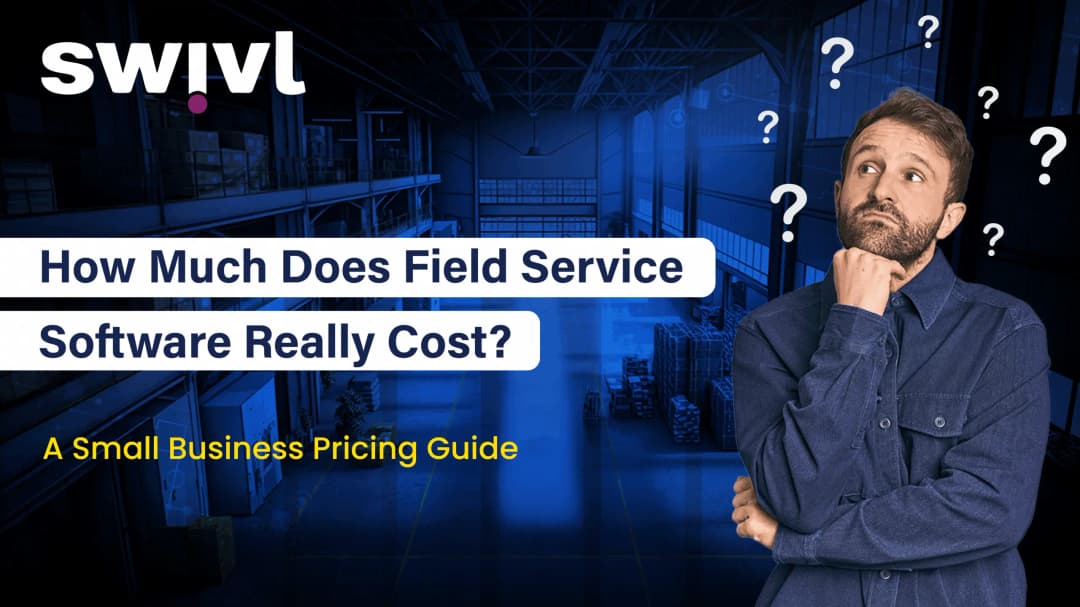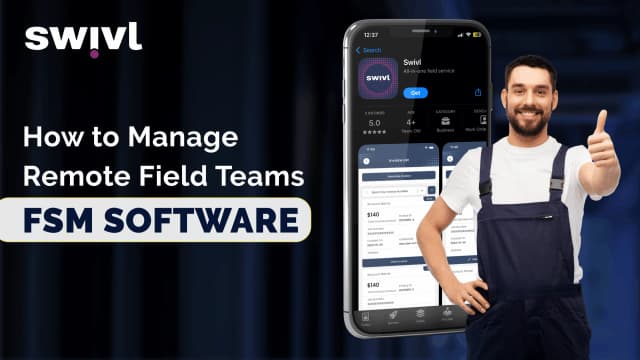You know you need field service software to streamline scheduling, invoicing, dispatching, and customer communication. But when you start researching, the pricing gets confusing. Some platforms say, "$30 per user," others hide fees behind custom enterprise plans. And then there are free versions with major limitations.
So what does it really cost to run your field service business on software and is it worth the investment?
In this detailed guide, we break down all the costs involved so you can make informed decisions and avoid budget surprises.
Understanding Field Service Software Pricing Models
Pricing structures in the field service software (FSM) space vary widely, depending on your team size, business goals, and the tools you need. Let’s break down the common pricing models:
1. Per-User Monthly Subscriptions
The most popular pricing model. You pay a fixed monthly rate per active user typically a technician or admin using the platform.
Starter Plans : $30–$50 per user/month
Mid-Tier Plans : $60–$100 per user/month
Premium Plans : $100–$150 per user/month
This model gives you flexibility to scale as your business grows. If you add three new technicians next month, your software scales with you no renegotiating contracts.
2. Tiered Pricing Structures
Most vendors offer tiered plans based on features:
Starter Plans : Basic scheduling, mobile access
Professional Plans : Add invoicing, reporting, and customer management
Enterprise Plans : Advanced analytics, automations, integrations, and team management
3. Flat-Rate or Site Licenses
Some companies offer one flat rate for unlimited users. Ideal for larger teams, but often not cost-effective for smaller operations.
According to Software Advice's 2024 FSM Buyer Report, nearly 78% of small businesses prefer per-user pricing due to its predictability and scalability.
Key Factors That Influence Pricing
1. Number of Users (Technicians/Admins)
This is your biggest cost driver. If you have five techs and one dispatcher, expect to multiply the base rate by six.
5 users: $150–$500/month
10 users: $300–$1,000/month
2. Features & Functional Depth
Basic FSM tools cover scheduling and work orders. But as your needs evolve, you'll want more:
Advanced reporting and business analytics
Route optimization
Inventory and asset tracking
Integrated payments
Digital signatures and mobile time-tracking
Real-time technician location tracking
Every added module or integration generally raises your costs.
3. Mobile App Capabilities
Field technicians need more than a calendar. They need access to:
Offline functionality
Image uploads
Signature capture
Job checklists
If your mobile app lacks functionality, productivity suffers.
4. Software Integrations
Need your FSM to sync with QuickBooks, Salesforce, or other platforms? Some vendors charge extra or restrict integrations to higher plans.
Total Cost Breakdown: What You’ll Actually Spend
Let’s look at the comprehensive cost of FSM software over a year.
1. Subscription Fees (5-Technician Team Example)
Basic plan: $150–$300/month
Professional plan: $300–$500/month
Premium plan: $500–$750/month
Annual range: $1,800 to $9,000
2. Setup & Implementation
DIY setup: Free to $500
Assisted onboarding: $500–$2,000
Custom implementation: $1,000–$5,000
Data migration: $300–$1,500
3. Training & Onboarding
Video tutorials: Usually free
Live virtual training: $200–$800/session
On-site sessions: $1,000–$3,000/day
Ongoing customer support: $50–$200/month
4. Add-On Modules & Services
Payment processing: 2.9% + $0.30 per transaction
Advanced reporting: $10–$30/user/month
API access: $50–$200/month
Custom integrations: $500–$5,000 per integration
Aberdeen Group estimates that SMBs spend 12–18% of annual revenue on business tech. For a $500,000 field service company, that’s $60,000–$90,000 per year, not just for FSM software, but CRM, accounting, payroll, and more.
Watch Out for Hidden Costs
A budget may look reasonable on the surface. But dig deeper, and you might uncover extra expenses:
1. Payment Processing Fees
$50,000 monthly card revenue × 2.9% = $1,450/month in processing fees.
2. Data Storage Limits
Basic plans may cap your upload size or archive duration. Need to store high-res photos or job notes for 5 years? Expect $10–$50/month in overage fees.
3. Premium Support
Standard support may include email/chat during business hours. If you need 24/7 support or a dedicated manager, that’s an extra $50–$300/month .
4. API & Integration Costs
QuickBooks, Xero, HubSpot, Salesforce—connecting any of them might require higher-tier plans or separate fees of $50–$500/month.
Understand cost structures in FSM to better evaluate software pricing against your business model.
Should You Consider Free Field Service Software?
There are free FSM tools on the market, but you get what you pay for.
Limitations of Free FSM Platforms:
Limited users (1–2 max)
No invoicing or payment features
Minimal reporting
No integrations
Barebones mobile functionality
When Free Makes Sense:
If you’re a solo operator or just testing the waters, a free plan helps you get organized. But most teams outgrow these platforms within 6–12 months.
Explore free and affordable tool alternatives to understand your options before committing to paid solutions.
The ROI of Investing in FSM Software
Field service software isn’t an expense, it’s an investment that quickly pays off.
Time & Cost Savings
10 admin hours saved weekly × $20/hour = $200/week
2 more jobs per tech per day × 5 days × $100 profit/job = $1,000/week
Annual impact : $62,400 in savings
Faster Invoicing, Better Cash Flow
Invoicing speed improves from 45-day cycles to 15. That frees up $25,000 in working capital on $50,000/month revenue.
Revenue Growth
With better scheduling, you may increase job volume by 15–20%. That’s real bottom-line impact.
Planning Your Budget the Smart Way
1. Start Lean, Scale Later
Pick a plan that covers your essentials—scheduling, dispatching, invoicing—and scale up when you need route optimization or BI dashboards.
2. Monthly vs. Annual Contracts
Annual = 10–20% discount, less flexibility
Monthly = Higher cost, more agility
3. Always Buffer 15–20%
Budget extra for add-ons, training, or features you didn’t anticipate.
Example First-Year Budget for 5 Techs
Software: $400 × 12 = $4,800
Onboarding: $1,500
Payment fees: $1,200
Add-ons: $600
Total: ~$8,100/year
How cost-effective software helps you scale explains the relationship between software investment and business growth.
What to Look for in Affordable FSM Software
Start by identifying the non-negotiables for your operations:
Drag-and-drop scheduling
GPS-tracked mobile dispatching
Digital invoicing & payments
Customer records with service history
Real-time technician tracking
Basic reporting and work order logs
Avoid overpaying for features like AI chatbots, multi-region routing, or business intelligence dashboards if you’re not ready to use them.
Vendor Evaluation Checklist:
Transparent pricing breakdown
Flexible contracts and upgrade paths
Integration capabilities
Customer service reviews
Setup and onboarding support
Is FSM Software Worth the Price?
The numbers don’t lie. Quality field service software can:
Increase daily job volume by 15–25%
Reduce admin time by 30–40%
Improve payment collection speed by 20–30%
Boost customer satisfaction by 10–15%
Without FSM, you’re left juggling spreadsheets, sticky notes, and missed appointments. The manual route might save $400/month today, but cost you tens of thousands in missed revenue and inefficiency.
Your competitors are already reaping the benefits of automation. The longer you wait, the harder it gets to catch up.
Why Swivl Is a Smart Choice for Growing Teams
Swivl is purpose-built for small and scaling field service businesses. Whether you're a solo operator or running a tight-knit team, Swivl gives you everything you need—without drowning you in features you'll never use or fees you didn’t see coming.
All core features are completely free—scheduling, dispatching, CRM, invoicing, and more
When you're ready, (pay as you grow features) plans start at just $45 per technician/month
Simple UI, fast onboarding, zero fluff Transparent pricing with no hidden modules or seat limits
If you’re just starting out or trying to do more with less Swivl lets you hit the ground running. Try the full platform, free and forever. When growth comes, you’ll already be ready.
Explore Swivl and see how it can transform your field service business.
Final Thoughts
Field service software isn’t optional anymore. It’s foundational.
The real question isn’t can you afford it? but can you afford not to?
With smarter scheduling, faster payments, and clearer operations, FSM software pays for itself often within 60 days. Start with your essentials, grow into advanced features later, and don’t get locked into overpriced systems that don’t deliver real value.
Explore options like Swivl to get the tools you need, without the stress of enterprise-level pricing.
Ready to make your business more efficient? Swivl gives you the power of premium field service software without the premium price tag.


